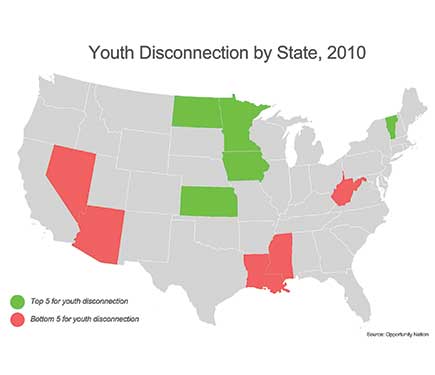Youth Are Worse Off Now Than in 1990
 •
•
Allie Bidwell, Reporter
By several measures, America is becoming more educated, but young people may have less opportunity now than in 1990.
The national high school graduation rate is the highest it’s been in decades, and the percentage of adults with some form of college degree has also been on the rise. Nationwide, about 26 percent of adults over 25 had at least an associate’s degree in 2010.
But there’s been a growing trend of inequality among young adults, according to a historical report from Opportunity Nation, a national campaign focused on expanding economic mobility.
Since 1990, the percentage of young people between the ages of 16 and 24 who are neither working nor in school has increased by 5 percent, to a national average of 14.7 percent in 2010. In some states – such as Mississippi, Nevada and Louisiana – the rate is as high as 20 percent, but in others – North Dakota, Minnesota and Vermont – it’s below 10 percent.
“Rather than laying the foundation for a productive life by gaining skills, identity and purpose through school and work, disconnected youth find themselves adrift at society’s margins, with long-term consequences for young people and for society,” the report says.

During the same time, income inequality has increased, as has the overall poverty rate, which rose from 13.1 percent in 1990 to 15.3 percent in 2010.
“Our country’s relatively modest progress is not nearly enough to ensure that Americans – particularly teens and young adults – have access to the critical economic, education and community supports that promote upward mobility,” said Mark Edwards, executive director of Opportunity Nation, in a statement. “It also prompts a closer look at states that have helped youth embark on meaningful educational and career pathways – the key to thriving communities and economies that benefit all of us.”
When looking at the bottom states in terms of youth disconnection, a pattern emerges. Of the 10 states with the highest youth disconnection rates, all but one have poverty rates above average, eight have high school graduation rates below average, seven have violent crime rates higher than average, and all have the smallest population of adults with at least an associate’s degree.
Nevada has the second-highest youth disconnection rate in the country, at 20 percent. It also has the second-highest violent crime rate (663 per 100,000), a slightly above-average poverty rate (14.9 percent), the lowest high school graduation rate (57.8 percent) and a postsecondary education rate in the bottom 10 in the country, at 28.7 percent.
Meanwhile, states with lower rates of youth disconnection generally fare better on these measures. Of the 10 with the lowest youth disconnection rates, just one (Massachusetts) has an above-average violent crime rate, at 468.9 per 100,000. Each of these 10 also has a poverty rate below the national average, just two have postsecondary education rates below average, and all but one have above-average high school graduation rates.
Vermont has the third-lowest youth disconnection rate, the second-lowest violent crime rate, among the lowest poverty rates, the seventh-highest college attainment rate, and the top high school graduation rate, at 91.4 percent.








